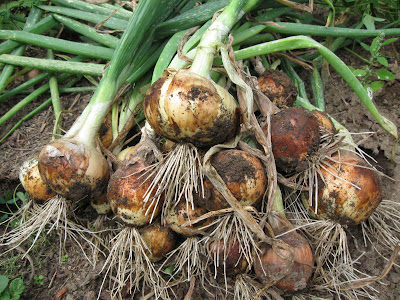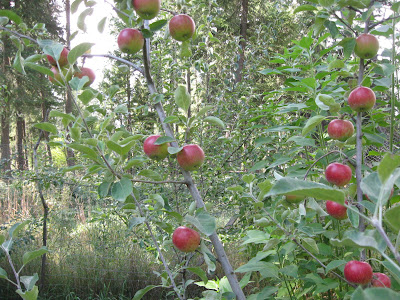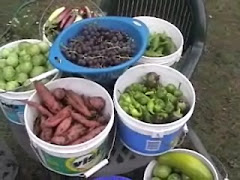 The vast majority of this year's tomatoes stubbornly refused to ripen on the vine. I coaxed and pleaded with them, all to no avail. Their fate was set in stone when spring declined her initial invitation and showed up late for the party. If I could have tossed a lasso around the sun and pulled it closer to our garden perhaps that would have helped...but alas I have no such magic.
The vast majority of this year's tomatoes stubbornly refused to ripen on the vine. I coaxed and pleaded with them, all to no avail. Their fate was set in stone when spring declined her initial invitation and showed up late for the party. If I could have tossed a lasso around the sun and pulled it closer to our garden perhaps that would have helped...but alas I have no such magic.So, with the rainy cool weather pushing the last of summer aside we made the decision to pick all but our cherry tomatoes rather than risk the possibility of dampness or even frost stealing away our crop in the next couple of days. Most, if not all, of these tomatoes were fully formed and should slowly ripen inside over the next few weeks. We've had to pick our tomatoes green many times in years past but never this many. I am happy though as I was somewhat concerned for a while that we would not even see the fruits fully develop this year.
All the tomatoes were removed from the buckets, wiped clean of water (we picked them in the rain) and placed in cardboard boxes on our porch. We will bring them into the house a few boxes at a time to help speed up the ripening process and slowly convert them into salsa, sauce, and such.
I believe this box contains a few German Strawberry, Kellog's Breakfast, and (hybrid) Margherita's. They all have such a pretty green hue to them don't you think.:)
 Yesterday I picked sweet (green) peppers from all but the potted pepper plants which were brought back into the greenhouse, I am hoping that they will ripen up a bit more. We will probably pull the remaining hot pepper plants and hang them upside down, this often helps them to finish ripening and hopefully "heat" up a bit as most are lacking in that department.
Yesterday I picked sweet (green) peppers from all but the potted pepper plants which were brought back into the greenhouse, I am hoping that they will ripen up a bit more. We will probably pull the remaining hot pepper plants and hang them upside down, this often helps them to finish ripening and hopefully "heat" up a bit as most are lacking in that department.
 My hots aren't hot and the Paprika has no color.:(
My hots aren't hot and the Paprika has no color.:( While our popping corn is still outside trying to finish forming we were able to harvest our Painted Mountain and Blue Jade corn. We didn't spare much space for corn in the garden this year as there is still an abundance left over from the previous season. Once the kernels have shriveled enough to be removed from the cob they will be put on a screen in front of our wood or pellet stove to finish hardening because they have a propensity to become moldy if they are not cured properly in a warm dry environment. We do the same with our sunflower seeds. All of our corn is dried, stored in gallon jars, and will be ground into cornmeal as needed.
While our popping corn is still outside trying to finish forming we were able to harvest our Painted Mountain and Blue Jade corn. We didn't spare much space for corn in the garden this year as there is still an abundance left over from the previous season. Once the kernels have shriveled enough to be removed from the cob they will be put on a screen in front of our wood or pellet stove to finish hardening because they have a propensity to become moldy if they are not cured properly in a warm dry environment. We do the same with our sunflower seeds. All of our corn is dried, stored in gallon jars, and will be ground into cornmeal as needed. I love the color variance that we get with these varieties of corn.
I love the color variance that we get with these varieties of corn. And then there is the squash. A dismal harvest, perhaps our worst ever. I left many squashes outside on the vine to finish growing but with this cold rainy weather I hold little hope for them unless a couple more weeks of warm dry weather shows itself. Thank goodness for large hubbards, sugar pie pumkins, and gold nuggets. All three of which struggled mightily but at least gave us a few mature specimens to be used sparingly throughout the winter.
And then there is the squash. A dismal harvest, perhaps our worst ever. I left many squashes outside on the vine to finish growing but with this cold rainy weather I hold little hope for them unless a couple more weeks of warm dry weather shows itself. Thank goodness for large hubbards, sugar pie pumkins, and gold nuggets. All three of which struggled mightily but at least gave us a few mature specimens to be used sparingly throughout the winter.Normally at this time of year the vines have begun to die back and the rind has hardened to the point that it can no longer be easily pierced by a thumbnail. I leave a couple inches of stem on the squash as they perspire through their stems, any without may begin to rot. Those that lack stems or have soft spots are always used first and are usually the ones we steam and freeze to be used as soup or in mashed squash dishes. Unblemished squash is allowed to cure on our porch for a couple weeks or until the temperature drops below 50° at which point it is brought inside and kept cool and dry, right around 50-65°
All of that said, I am very excited to harvest our root veggies as I think they will be our summer's shining star. We hope to begin harvesting beets, carrots, potatoes, and parsnips as soon as we are afforded a couple of dry days in which to work.




































